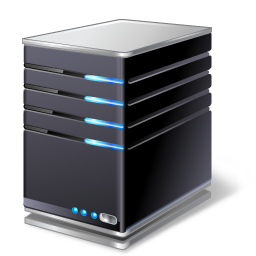Computer Types
Personal Computer or PC
![]()
Today a personal computer is an all rounded device that can be used as a productivity tool, a media server and a gaming machine. The modular construction of the personal computer allows components to be easily (at least for desktop units) swapped out when broken or upgraded.
Although occasionally "PC" is used to refer to the family of computers descended from the original IBM-PC, it is now typically used for any general purpose computing platform available (according to price) for the home market, including laptops and Apple computers.
Server

Servers are similar to mainframes in that they serve many uses with the main difference that, usually, the users (called clients) do much of their own processing. The server processes are devoted to sharing files and managing access rights.
A server is a central computer that contains collections of data and programs. Also called a network server, this system allows all connected users to share and store electronic data and applications. Two important types of servers are file servers and application servers.
An application server hosts various applications or programs that you can use without having to install them directly on your system. Web apps, like Google Docs, work in essentially the same way.
A file server manages your files. These files are not actually located on your computer's hard disk, but appear to be so.
A web server is essentially a file server located somewhere in the Internet. You request files (or web pages) by clicking on a (hyper)link or typing in a URL. The file is displayed by your browser as a web page. Much of the web has been developed using this client-server model
Smartphones
![]()
Smartphones are hand-held computers. The current generation of smartphones run an amazing array of applications, making them quite general purpose. Their primary inadequacy at this time is the limitations for directly connected I/O devices, like a printer. They have a keyboard and touch screen for input, with only a screen for output. Bluetooth wireless networking (the same you may use for a phone headset) handles the problem of connecting peripherals, and the Internet, which can be viewed as both an input and an output device for our purposes, handles more.
The number of mature applications for smartphones is growing rapidly. Nowadays, the smartphone become the mobile platform for business and personal use.
Workstation

Workstations are high-end, expensive computers that are made for complex procedures and are intended for one user at a time. Some of the complex procedures consist of science, math and engineering calculations and are useful for computer design and manufacturing. Workstations are sometimes improperly named for marketing reasons. Real workstations are not usually sold in retail.
Perhaps the first computer that might qualify as a "workstation" was the IBM 1620.
In current terminology, a desktop personal computer (or even a terminal) connected to a server, mainframe, or network is often called a workstation. In addition, the line separating workstations from personal computers is blurring as PCs become more powerful and workstations become cheaper.
Cloud Computing

Although "the cloud" is not a single computer system, it seems that this is a good place to discuss it. First, it is worth noting that servers are also often not a single computing system. All of our Google queries aren't sent to a single machine on the Internet, but it acts that way. This is somewhat like cloud services (in fact Google offers cloud services).
In cloud computing, your PC acts as a client, perhaps with little more hardware and software than is needed to run an operating system and a web browser. Cloud applications are run on some (unknown) application server in the Internet and your data is stored on some (unknown) file server in the Internet.
This offers the potential of significant costs savings, especially in business settings where you otherwise have to have many computers, each with their own hardware and software.
Supercomputer

Supercomputers are fast because they are actually many computers working together.
Supercomputers were introduced in the 1960's as the world's most advanced computer. These computers were used for complex calculations such as forecasting weather and quantum physics. Today, supercomputers are one of a kind; they are fast and very advanced. The term supercomputer is always evolving as tomorrow's normal computers are today's supercomputer. As of May 2011, Sunway Taihu Light is ranked on the TOP500 list as the fastest supercomputer. It consists of 40,960 CPUs each with 256 processing cores (a quad-core has four).
Although it is energy efficient, supercomputers are still room-sized machines
Mainframe

Mainframes are computers in which all the processing is done centrally, and the user terminals are called "dumb terminals" since they only input and output (and do not process). In modern systems, a PC or a web app often acts as the dumb terminal.
Mainframes are computers used mainly by large organizations for critical applications, typically bulk data processing such as a census. Examples: banks, airlines, insurance companies, and colleges. They support hundreds of users simultaneously.
Microcontroller
Microcontrollers are mini computers that enable the user to store data and do simple commands and tasks with little or no user interaction with the processor. These single circuit devices have minimal memory and program length but can be integrated with other processors for more complex functionality. Many such systems are known as Embedded Systems. Examples of embedded systems include cell phones and car safety and control systems. Embedded systems are limited to specific tasks, but are often part of a much more complex system.
